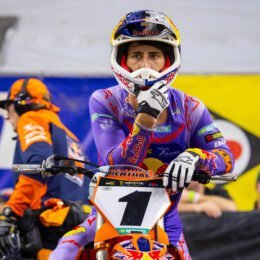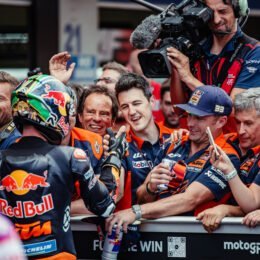GETTING FAST WITH FOUR AND THE VIRTUAL WORLD
KTM are competing on almost every continent with two wheels but they are also pretty busy with their four-wheel program. Marketing and Motorsport Manager and driver Laura Kraihamer tells us about throttling the KTM X-BOW Models and how technology is making racers faster and younger…
By Adam Wheeler

PC: Gruppe C Photography
Laura Kraihamer has been intrinsically linked with KTM’s X-BOW for over a decade. The 32-year-old from Salzburg first drove one of the Austrian sportscars back in 2012 and has had an official role with KTM in racing, testing and promoting the X-BOW for the last six seasons.
During its 15-year life span, the KTM X-BOW has progressed from a small, radical side project within the company to a bona fide motorsports asset that has tasted success and led to the GT-XR, that KTM describe as ‘the closest you can get to a pure-bred race car in a road legal vehicle’. The READY TO RACE mantra extends to any type of powered product it seems.

PC: Kristijan Knezevic
Kraihamer has had her hands all over the car that is currently starring in different series like the Fanatec GT2 European Series or the Creventic 4H Series. Don’t dismiss the seriousness or the international scope of the car calendar for the X-BOW crew and Kraihamer with her R&D on top. “The agenda can change but last year was quite intense,” Laura tells us. “We were on the track at least 25-30 weekends a year between testing, racing and development. Usually, the team can vary between 15-20 people, depending if we bring one car or two, sometimes three! There can be a lot going on, but I would say the core team is 10-15, not including the drivers.”
Kraihamer has wins or podiums across a number of contests: GT4, Endurance and Nürburgring Nordschleife to name a few. She how has to balance management of the team with management of the wheel. “I think every driver, deep down, just wants to focus on being a driver!” she smiles. “But this new role has been challenging, interesting and was a bit strange in the beginning. It’s another function in racing. I think I can relate to a lot of things differently compared to someone who has perhaps not been in the situations I have, and I’m lucky to have a team that supports this double role in an incredible way.”

PC: Philip Platzer
“I feel like the KTM X-BOW has always been fighting against tough opponents and has been very much the underdog,’ she adds. “One thing we are trying to create is awareness because many people don’t know what we do, or they underestimate it or don’t believe what we are capable of. We have started to show a lot more in the last couple of years with the GTX and GT2 race cars which have won important races and championships in their first outings, and shown amazing pace and performance even when they were prototypes. We have an impressive group of people involved, driven by passion; I don’t think a lot of what we achieve would be possible without that.”
Passion but also pace has been responsible for the growing credibility of a sportscar effort produced by Europe’s largest powered two-wheel manufacturer. “Yes, and especially inside the business,” Kraihamer concurs. “People have seen what the car can do. There have been many events when we’ve been inside a race against the big car brands and we’ve been 100% competitive against them. The standing of the KTM X-BOW has changed a lot but we’ve stayed true to KTM core values, and values for racing.”

PC: AG Photo
The Pierer Mobility Group have added brands and have diversified their products in the past five years, especially with the burgeoning bicycle market. Has this weakened the case for the KTM X-BOW?
“No, not at all,” Kraihamer asserts. “Everyone I meet is super-interested and there is a lot of people wanting to integrate the KTM X-BOW into their own promotional activities. People find it cool! I feel that the X-BOW has as much standing as any other product in the company and I like that the [Pierer Mobility] group has not only stayed orange but opened its mind to many more things. It’s fascinating for me that everyone knows KTM’s core values and the product range is so big under the umbrella but there still isn’t one where you might think ‘this is not true to what KTM stands for…’”
If there is one defining characteristic of KTM then it’s racing. Kraihamer is part of the breed and insists she still has the skills, speed and – crucially – the know-how to slice a lap-time and rub some paint.

PC: Gruppe C Photography
“I actually started racing quite late,” she says. “Normally drivers are karting from a young age but I did only three-four years because I did not have the financial background. I started racing cars at 22 and the problem there is that you spend very little time in the actual race car! If you want to drive and test then you need the whole crew, the transportation, the tires, fuel, engineers, mechanics, the circuits! It’s very difficult, so every minute and mile you spend in the car adds to you experience. That’s why racers who are over 30 years of age or have been on the circuit for over ten years are often just as quick – or quicker – as the youngsters.”
The Austrian has been able to rely on the rapid march of technology and specifically the boom of Sim Racing to help. Companies like GT series sponsor Fanatec produce high-spec components to allow drivers or companies to construct rigs and run software and hardware that take professional racers as close to the real thing as possible. “The Sim racing business has really changed the game,” Laura says. “It gives the possibilities to youngsters to gain as much experience as someone who have been in racing for quite some time.”
“It has become another training possibility,” she adds. “We have a rig at the company. It’s quite big! It’s something where the technology has progressed so much and it’s very helpful in a lot of areas.”

PC: Felix Steinreiber
Gaming consoles like PlayStation and Xbox used to have motorsport titles that were useful for their primitive accuracy for venues, circuits and even vehicle handling, in some cases. According to Kraihamer the practicality is now essential for preparation.
“At some point the Sim is necessary,” she says. “I think people were playing games and using a basic Sim racer just to get to know the tracks and which way the layout went. It has really changed. If you are working with good material then every bump or tarmac change on the track can be recreated. These details are important and while you can never recreate the exact feeling of the car you can still make a lot of situations with things like brake set-up and markers and weather to learn a lot through a simulator.”

The ability to ‘virtually’ drive means that Kraihamer believes “I’m faster and smarter than I’ve ever been. I guess it is a different kind of ‘fast’: still hungry to win but then also making better choices.”
Out of the cockpit she has had to oversee a bigger implication of the KTM X-BOW, namely fabrication of the GT-XR; a lightweight, firebreather with excellent fuel consumption (a 96l tank with an estimate 900km range). “We now have a road-going version based on the GT2 car and that is another milestone: a sportscar, derived from a race car, and is road legal. It’s been great to see the first ones on the road in Europe and to build that awareness even more.”



